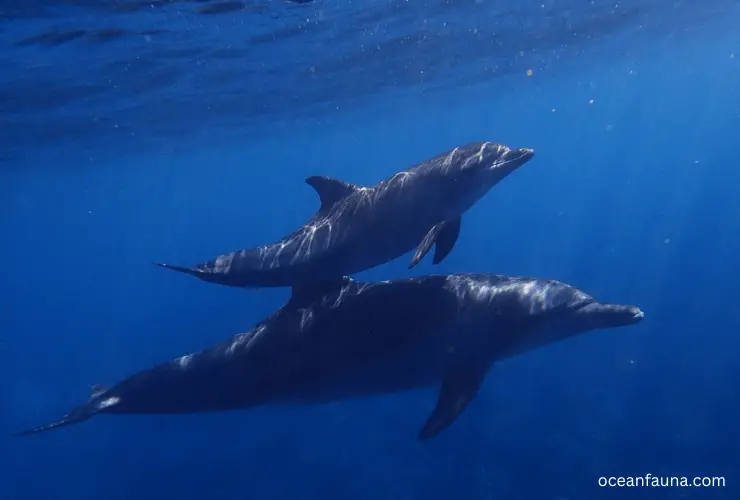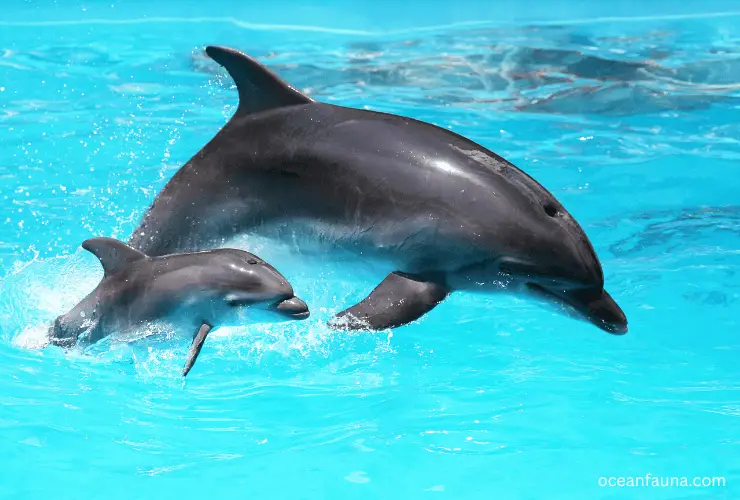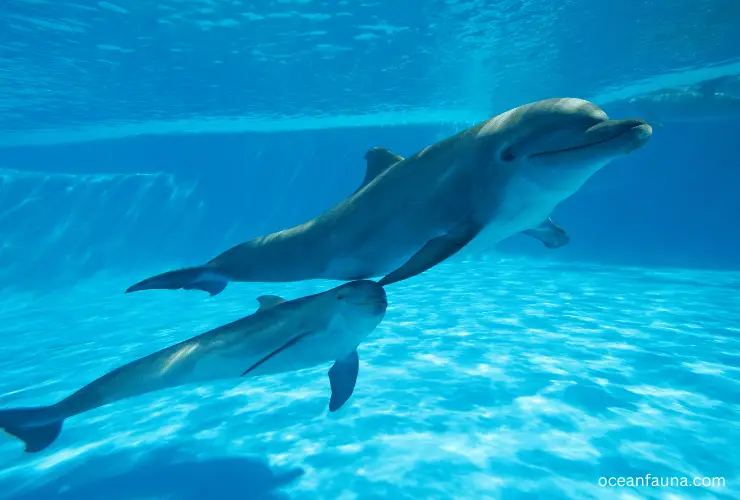Dolphins do not lay eggs like fish. Instead, they give birth to their young like other mammals. Not only that, but a mother dolphin also feeds her baby milk too.
Are you surprised? Then this article has more surprising facts for you. Read thoroughly to discover them.
Do Dolphins Lay Eggs?
No, dolphins do not lay eggs. Dolphins are mammals, meaning they belong to the class of animals that give birth to live young and feed them with milk.
Mammals have evolved over time in such a way that they no longer lay eggs as many fish and reptiles do. Instead, their reproductive system is much different than that of egg-laying species.
Dolphins, like other mammals, use internal fertilization, where sperm is transferred from the male dolphin to the female’s uterus, and then the embryo can develop within her uterus instead of an egg being laid outside her body.
The mother then gives birth to a live baby dolphin instead of an egg hatching out of an aquatic nest.
In addition to internal fertilization, dolphins also have several traits that set them apart from fish, including horizontal tail movement for swimming (unlike fish which move their tails up and down for propulsion) and very large brains due to their advanced intelligence and ability to learn behaviours quickly.
These characteristics together set dolphins apart from egg-laying species like many fish and reptiles, making it clear why dolphins do not lay eggs.
How Does a Dolphin Give Birth?
A dolphin gives birth by pushing the baby out of the birth canal. This is known as parturition. During labour, the female dolphin can be most active and restless as she looks for shallow water or a place to rest during the birthing process.
The baby dolphin usually emerges tail first to reduce its risk of drowning while it transitions from life inside the mother’s womb to life in the outside world.
The entire process of giving birth may take up to a few hours, depending on various factors such as genetic heritage and the size of the calf. As soon as the baby comes out, fluids will be expelled from its lungs so it can start breathing air.
After that, it begins nursing from its mother’s mammary gland within about 10 minutes. During this time, mothers will often help their new-borns up to the surface for their first breath of new air by supporting them with their fluke (tail).
At birth, calves are fully dependent on their mother for nutrition and protection from predators. Dolphins have thick paste-like milk, which contains valuable nutrients such as lipids, carbohydrates, proteins and minerals that can no longer be found through yolk absorption in a mature fetus as humans do.
This milk has about five times higher concentrations when compared to human milk and is necessary for the proper growth and development of calves until they reach an age where they can hunt and feed on fish by themselves.
While new-born dolphins feed primarily on milk initially, they begin developing their ability to catch fish at an early age by imitating hunting techniques exhibited by adults in their pod; some calves become efficient hunters within just six months of being born.
Although humans rarely witness dolphins giving birth due to their aquatic nature, it is estimated that new-borns represent over 50% of all bottlenose dolphins in temperate oceans such as those surrounding Europe and North America.
How Many Babies Can a Dolphin Give Birth To At Once?
A dolphin can only give birth to one baby at a time. This is because dolphins give live birth, meaning their young are born alive and ready to swim and breathe on their own, much like horses or cows.
Live births are generally limited to one offspring due to the large size of the mother’s pelvic area and the need for larger amounts of energy and resources to support multiple babies at once.
Nature has designed it this way so that infants get the full attention of their mothers, as she only has the capacity to nurture and protect one baby at a time. In doing so, new-borns are guaranteed adequate care from their mom.
How Many Months Does a Dolphin Remain Pregnant?
A bottlenose dolphin is typically pregnant for a total of 12 months. This is an incredibly long gestation period compared to other mammals and helps explain why dolphins are born with such a small degree of development.

During this time, the baby dolphin develops in the mother’s uterus, although there is very little room for it to do so due to the size and shape of the uterus. As a result, the tail fluke and dorsal fin are folded over in order to make birth easier.
The 12-month pregnancy period can be broken down into three distinct phases: early gestation (0-4 months), mid-gestation (4-8 months) and late gestation (8-12 months). During this time, the baby grows from a single cell into a viable fetus that has all its organs formed by about eight months old.
The last four months involve further growth of the baby’s body organs and continued development of its nervous system and sensory capabilities. By 12 months old, the baby should be ready for birth and emerge at full term.
Each stage of dolphin pregnancy has its own unique challenges and risks associated with it. During early gestation, dolphins face complications related to implantation failure due to low progesterone levels or endocrine disruption caused by environmental pollutants.
Mid-to-late gestation involves risk factors such as premature birth or fetal malformation due to maternal malnutrition or other issues.
These risks also increase significantly if a female dolphin has multiple pregnancies within a short period of time. Despite these risks, most dolphins can successfully carry their foals throughout their entire 12-month pregnancy before giving birth at full term.
How Many Times Do Female Dolphins Ovulate?
Female dolphins experience 2 to 7 ovulations each year, which usually span a 30-day cycle from the start of spring until fall. Their estrous cycles can range between 21 and 42 days but normally remain consistent at around one month. At this time, they release a single egg into the water column, where it is fertilized by male bottlenose dolphins nearby.

Male bottlenose dolphins have multiple partners during any given reproductive season, so it’s likely that each female dolphin has multiple mates throughout her estrous cycles.
However, it has been observed that female bottlenose dolphins sometimes form pair bonds with certain males for extended periods of time during some parts of their estrous cycles. This suggests that female dolphins may have some control over which mates they choose for reproduction.
In addition to multiple mating opportunities, female dolphins can also regulate their fertility through hormones such as progesterone and prolactin.
By controlling reproductive processes such as ovulation and implantation of eggs within the uterus wall, female dolphins can modulate how many times they ovulate or even stop themselves from reproducing completely if conditions are not ideal. This helps ensure healthy offspring and successful reproduction overall.
Do Dolphins Mate Forever?
No, dolphins do not mate for life or forever. Although some believe that bonds between males are the strongest and most enduring in bottlenose dolphin societies, these mammals tend to form strong social bonds with other dolphins within their pod, but the connections aren’t necessarily monogamous.
Dolphins live in what are called fission-fusion societies, where pods are constantly changing in size and numbers due to various factors such as mating, migration, and environmental events. This means that males may have different partners over their lifetime.

Dolphin mating rituals vary by species and frequently involve physical contact such as touching, vocalizing, and swimming in syncopation; however, these complex behaviours do not always result in mating or a long-term monogamous relationship.
Studies show that male dolphins form alliances with other male dolphins to help females get a chance to mate. This is because male dolphins compete for access to females.
In addition, female dolphins are thought to be promiscuous, meaning they mate with multiple males throughout their reproductive lifespan.
How Often Does a Dolphin Reproduce?
Dolphins’ childbirth frequency can vary depending on the species. For example, female Bottlenose dolphins typically have a three to six year period between giving birth to calves. This is due to the fact that pregnancy in dolphins can last up to 12 months, and lactation periods can last nearly as long.

Additionally, the physical toll of giving birth affects their ability to reproduce quickly; for this reason, a female dolphin may take several years to recover before being able to bear another calf.
In some cases, female dolphins experience what is known as a “lactation pause”; during this time, they will not give birth for multiple years at a time, even if they are capable of reproducing.
FAQs
What’s a baby dolphin called?
A baby dolphin is called a calf. Dolphin calves are born after a gestation period of around 12 months and typically measure between 2 and 4 feet in length at birth. They are usually born tail first, and their mother will help to guide them to the surface for their first breath of air.
Dolphin calves have a thick layer of blubber which helps them stay warm and insulated in the water, while they also rely heavily on their mothers for protection against predators.
Dolphins form strong bonds with their mothers, who will nurse the calf for up to two years after her initial birth. This allows the calf to learn essential survival skills such as breathing techniques and how to hunt effectively.
During this time, they can even be observed playing with each other, similar to the way humans do during childhood. By adulthood, dolphins reach lengths of 6 to 12 feet depending on the species, with males being slightly larger than females on average.
Do dolphins give milk to their young?
Yes, dolphins do give milk to their young. Milk is one of the primary ways that dolphins feed their calves.
The mammary glands of female dolphins produce rich, highly nutritious milk that contains between 5-10% fat and very high amounts of proteins, carbohydrates, minerals, and vitamins.
Dolphins typically feed their calves with milk for several months until they are able to transition to solid food. They nurse by taking turns suckling on the mother dolphin’s nipples or teats, which are located just beneath the dorsal fin.
In addition to providing nourishment and hydration, nursing helps build bonds between the mother and her calf, ensuring survival and increasing social support within their pod. The milk also aids in developing the calf’s immune system so it can successfully fight off disease and infection.
Once calves reach sexual maturity at around four years old, they will no longer nurse from their mother since she will be nursing her new calf.
Conclusion
So, it is confirmed that, since dolphins are mammals, they can’t lay eggs just like whales. Rather they give birth to young children and feed them milk for several months.
So, next time you see a dolphin, do think they are egg-laying creatures like fish.


2 thoughts on “Do Dolphins Lay Eggs? [Dolphins’ Reproduction]”